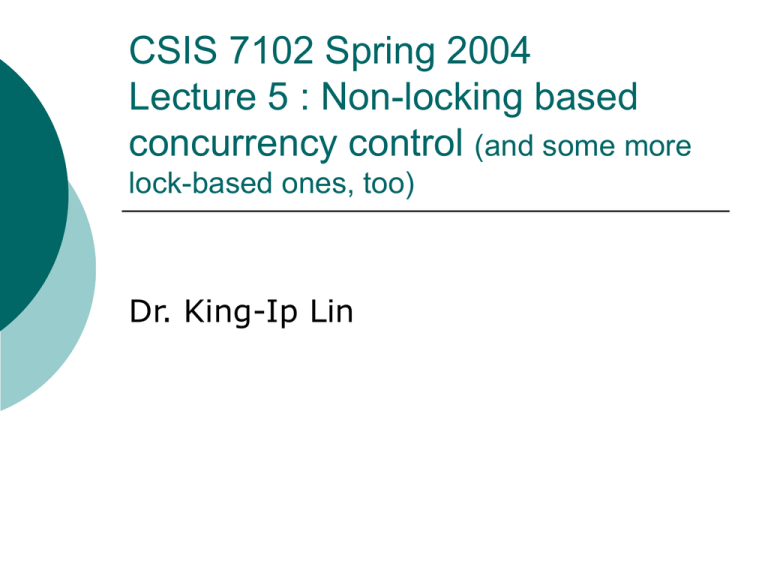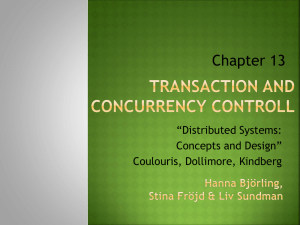Timestamp ordering / Optimistic concurrency control
advertisement

CSIS 7102 Spring 2004 Lecture 5 : Non-locking based concurrency control (and some more lock-based ones, too) Dr. King-Ip Lin Table of contents Limitation of locking techniques Timestamp ordering View serializability Optimistic concurrency control Graph-based locking Multi-version schemes The story so far Two-phase locking (2PL) as a protocol to ensure conflict serializability Deadlock handling in 2PL The phantom problem Multi-granularity locking Once a transaction start releasing locks, cannot obtain new locks Ensure that the conflict cannot go both direction Intention locks Improving concurrency while maintaining correctness Levels of isolation Not every transaction need 2PL to be correct Ability to define which isolation level for a transaction to be run Enable even higher concurrency Limitation of lock-based techniques Lock-based techniques ensure correctness However, it tends to be a bit “pessimistic” Some schedules that are serializable will not be allowed under the locking protocol. Limitation of lock-based techniques Example: 1. A1 <- Read(X) 2. A1 <- A1 – k 3. Write(X, A1) 4. A2 <- Read(Y) 5. A2 <- A2 + k 6. Write(Y, A2) 1. A1 <- Read(X) 2. A1 <- A1* 1.01 3. Write(X, A1) 4. A2 <- Read(Y) 5. A2 <- A2 * 1.01 6. Write(Y, A2) Is this schedule serializable? Limitation of lock-based techniques However, 2PL does not allow it 1. A1 <- Read(X) 2. A1 <- A1 – k 3. Write(X, A1) 4. A2 <- Read(Y) 5. A2 <- A2 + k 6. Write(Y, A2) Blocked (T1 already has Xlock); T2 cannot proceed 1. A1 <- Read(X) 2. A1 <- A1* 1.01 3. Write(X, A1) 4. A2 <- Read(Y) 5. A2 <- A2 * 1.01 6. Write(Y, A2) Limitation of lock-based techniques Why does 2PL block this operation? There is a conflict between T1 and T2 If we allow T2 to go on, there is a potential danger that T2 can finish before T1 resumes, which leads to a non-serializable schedule Thus, 2PL decide to “play safe” Limitation of lock-based techniques But is 2PL “playing TOO safe”? 1. A1 <- Read(X) 2. A1 <- A1 – k 3. Write(X, A1) 4. A2 <- Read(Y) 5. A2 <- A2 + k 6. Write(Y, A2) Schedule may still be serializable if we allow this 1. 2. 3. 4. 5. 6. A1 <- Read(X) A1 <- A1* 1.01 Write(X, A1) A2 <- Read(Y) A2 <- A2 * 1.01 Write(Y, A2) Only if we allow this to go before T1 resume, then the schedule becomes unserializable Limitation of lock-based techniques In some cases, 2PL is playing too safe Can we allow for more concurrency? (e.g. allow some conflicting operation to go ahead, until we can determine that a schedule is not serializable) One method: dynamically keep track of serializability graph Check before each operation to see if a cycle will appear Not practical A more practical approach: predefine allowable conflict operations, so that a cycle is never formed Timestamps Timestamp ordering Timestamp (TS): a number associated with each transaction Not necessarily real time Can be assigned by a logical counter Unique for each transaction Should be assigned in an increasing order for each new transaction Timestamp ordering Timestamps associated with each database item Read timestamp (RTS) : the largest timestamp of the transactions that read the item so far Write timestamp (WTS) : the largest timestamp of the transactions that write the item so far After each successful read/write of object O by transaction T the timestamp is updated RTS(O) = max(RTS(O), TS(T)) WTS(O) = max(WTS(O), TS(T)) Timestamp ordering Given a transaction T If T wants to read(X) If TS(T) < WTS(X) then read is rejected, T has to abort Else, read is accepted and RTS(X) updated. Why is RTS(X) not checked? For a write-read conflict, which direction does this protocol allow? Timestamp ordering If T wants to write(X) If TS(T) < RTS(X) then write is rejected, T has to abort If TS(T) < WTS(X) then write is rejected, T has to abort Else, allow the write, and update WTS(X) accordingly For a read-write/write-write conflict, which direction does this protocol allow? Timestamp ordering -- example Consider the two transactions 1. 2. 3. 4. 5. 6. A1 <- Read(X) A1 <- A1 – k Write(X, A1) A2 <- Read(Y) A2 <- A2 + k Write(Y, A2) T1 (TS = 10) 1. 2. 3. 4. 5. 6. A1 <- Read(X) A1 <- A1* 1.01 Write(X, A1) A2 <- Read(Y) A2 <- A2 * 1.01 Write(Y, A2) T2 (TS = 20) Initially all RTS and WTS = 0 Timestamp ordering -- example Consider the following schedule 1. A1 <- Read(X) 2. A1 <- A1 – k 3. Write(X, A1) RTS(X) : WTS(X) : RTS(Y) : WTS(Y) : 10 0 00 10 00 00 4. A2 <- Read(Y) 5. A2 <- A2 + k 6. Write(Y, A2) T1 (TS = 10) TS(T1) > WTS(X) = 0, read allowed; TS(T1) > WTS(X) = 0; RTS(X) 10 TS(T1) = RTS(X) = 10; write allowed; WTS(X) 10 1. A1 <- Read(X) 2. A1 <- A1* 1.01 3. Write(X, A1) 4. A2 <- Read(Y) 5. A2 <- A2 * 1.01 6. Write(Y, A2) T2 (TS = 20) Timestamp ordering -- example Consider the following schedule 1. A1 <- Read(X) 2. A1 <- A1 – k 3. Write(X, A1) TS(T2) = RTS(X) = 20 TS(T2) > WTS(X) = 10, write allowed; WTS(X) 20 RTS(X) : WTS(X) : RTS(Y) : WTS(Y) : 20 10 20 0 0 4. A2 <- Read(Y) 5. A2 <- A2 + k 6. Write(Y, A2) T1 (TS = 10) TS(T2) > WTS(X) = 10, read allowed; RTS(X) 20 1. A1 <- Read(X) 2. A1 <- A1* 1.01 3. Write(X, A1) 4. A2 <- Read(Y) 5. A2 <- A2 * 1.01 6. Write(Y, A2) T2 (TS = 20) Timestamp ordering -- example Consider the following schedule 1. A1 <- Read(X) 2. A1 <- A1 – k 3. Write(X, A1) RTS(X) : WTS(X) : RTS(Y) : WTS(Y) : 20 20 10 10 4. A2 <- Read(Y) 5. A2 <- A2 + k 6. Write(Y, A2) T1 (TS = 10) 1. A1 <- Read(X) 2. A1 <- A1* 1.01 3. Write(X, A1) Similarly, at the end of this step 4. A2 <- Read(Y) 5. A2 <- A2 * 1.01 6. Write(Y, A2) T2 (TS = 20) Timestamp ordering -- example Consider the following schedule 1. A1 <- Read(X) 2. A1 <- A1 – k 3. Write(X, A1) RTS(X) : WTS(X) : RTS(Y) : WTS(Y) : 20 20 20 10 20 1. A1 <- Read(X) 2. A1 <- A1* 1.01 3. Write(X, A1) 4. A2 <- Read(Y) 5. A2 <- A2 + k 6. Write(Y, A2) TS(T2) > WTS(Y) = 10, read allowed; RTS(Y) 20 T1 (TS = 10) T2 (TS = 20) 4. A2 <- Read(Y) 5. A2 <- A2 * 1.01 6. Write(Y, A2) TS(T2) = RTS(Y) = 20 TS(T2) > WTS(Y) = 10, write allowed; WTS(Y) 20 Timestamp ordering -- example Now,consider the following schedule 1. A1 <- Read(X) 2. A1 <- A1 – k 3. Write(X, A1) RTS(X) : WTS(X) : RTS(Y) : WTS(Y) : 10 0 00 10 00 00 4. A2 <- Read(Y) 5. A2 <- A2 + k 6. Write(Y, A2) T1 (TS = 10) TS(T1) > WTS(X) = 0, read allowed; TS(T1) > WTS(X) = 0; RTS(X) 10 TS(T1) = RTS(X) = 10; write allowed; WTS(X) 10 1. 2. 3. 4. 5. 6. A1 <- Read(X) A1 <- A1* 1.01 Write(X, A1) A2 <- Read(Y) A2 <- A2 * 1.01 Write(Y, A2) T2 (TS = 20) Timestamp ordering -- example Consider the following schedule 1. A1 <- Read(X) 2. A1 <- A1 – k 3. Write(X, A1) TS(T2) = RTS(X) = 20 TS(T2) > WTS(X) = 10, write allowed; WTS(X) 20 RTS(X) : WTS(X) : RTS(Y) : WTS(Y) : 20 10 20 0 0 4. A2 <- Read(Y) 5. A2 <- A2 + k 6. Write(Y, A2) T1 (TS = 10) TS(T2) > WTS(X) = 10, read allowed; RTS(X) 20 1. 2. 3. 4. 5. 6. A1 <- Read(X) A1 <- A1* 1.01 Write(X, A1) A2 <- Read(Y) A2 <- A2 * 1.01 Write(Y, A2) T2 (TS = 20) Timestamp ordering -- example Consider the following schedule 1. A1 <- Read(X) 2. A1 <- A1 – k 3. Write(X, A1) TS(T2) > WTS(Y) = 0, read allowed; RTS(Y) 20 TS(T2) = RTS(Y) = 20 TS(T2) > WTS(Y) = 0, write allowed; WTS(X) 20 RTS(X) : WTS(X) : RTS(Y) : WTS(Y) : 20 20 20 0 20 4. A2 <- Read(Y) 5. A2 <- A2 + k 6. Write(Y, A2) T1 (TS = 10) 1. 2. 3. 4. 5. 6. A1 <- Read(X) A1 <- A1* 1.01 Write(X, A1) A2 <- Read(Y) A2 <- A2 * 1.01 Write(Y, A2) T2 (TS = 20) Timestamp ordering -- example Consider the following schedule 1. A1 <- Read(X) 2. A1 <- A1 – k 3. Write(X, A1) RTS(X) : WTS(X) : RTS(Y) : WTS(Y) : 20 20 20 20 4. A2 <- Read(Y) 5. A2 <- A2 + k 6. Write(Y, A2) T1 (TS = 10) 1. 2. 3. 4. 5. 6. A1 <- Read(X) A1 <- A1* 1.01 Write(X, A1) A2 <- Read(Y) A2 <- A2 * 1.01 Write(Y, A2) TS(T1) < WTS(Y) = 20, read rejected; T1 aborts! T2 (TS = 20) Timestamp ordering Thus, in timestamp ordering, conflicts are allowed from transactions with smaller timestamps to larger timestamps In other words, serializability graph will have only this kind of edges transaction with smaller timestamp Thus, no cycles transaction with larger timestamp Timestamp ordering – good & bad Advantages of timestamp ordering No waiting for transaction Thus, no deadlocks Disadvantages Schedule may not be recoverable (see previous example) Why? Long transaction may be aborted more often Why? Timestamp ordering – overcoming disadvantages Solution for recoverability Forcing all writes at the end of transactions; as well as making writes atomic (no other transaction can access any written item until all are written) Block (only) reading of dirty items (using locks) Use idea of commit dependency (discussed later) Solution for starvation Assign new timestamp for aborted transaction Temporary block short transactions to allow long transaction to go on (tricky to implement) Locks -- implementation Various support need to implement locking OS support – lock(X) must be an atomic operation in the OS level i.e. support for critical sections Implementation of read(X)/write(X) – automatically add code for locking Lock manager – module to handle and keep track of locks Thomas’ write rule Write-write conflict may be acceptable in many cases Suppose T1 do a write(X) and then T2 do a write(X) and there is no transaction accessing X in between Then T2 only overwrite a value that is never being used In such case, it can be argued that such a write is acceptable Thomas’ write rule In timestamp ordering, it is referred as the Thomas write rule: If a transaction T issue a write(X): If TS(T) < RTS(X) then write is rejected, T has to abort Else If TS(T) < WTS(X) then write is ignored Else, allow the write, and update WTS(X) accordingly A schedule allowed by Thomas write rule may not be conflict serializable, but is known to be view serializable. View serializability Let S and S´ be two schedules with the same set of transactions. S and S´ are view equivalent if the following three conditions are met: 1. For each data item Q, if transaction Ti reads the initial value of Q in schedule S, then transaction Ti must, in schedule S´, also read the initial value of Q. 2. For each data item Q if transaction Ti executes read(Q) in schedule S, and that value was produced by transaction Tj (if any), then transaction Ti must in schedule S´ also read the value of Q that was produced by transaction Tj . 3. For each data item Q, the transaction (if any) that performs the final write(Q) operation in schedule S must perform the final write(Q) operation in schedule S´. View serializability View equivalence is also based purely on reads and writes alone. Roughly speaking, for two view equivalent schedules, each corresponding read(X) read the same value (including initial read) Strictly speaking, it is stronger, as it is required to be the value produced by the same transaction The final value of each X has to be written by the same corresponding transaction(s) View serializability A schedule is view serializable if it is view equivalent to a serial schedule Conflict serializable view serializable But NOT vice versa 1. Read(X) 2. Write(X) 1. Write(X) 1. Write(X) T1 T2 T3 This schedule is view serializable to the schedule (T1, T2, T3) but not conflict serializable (R-W conflict T1->T2, W-W conflict T2->T1) View serializability 1. Read(X) 2. Write(X) Blind writes 1. Write(X) 1. Write(X) T1 T2 T3 Blind writes: writes that write values not based on previous reads View serializability = conflict serializability + blind writes Currently, view serializability is not very practical Determining whether a schedule is view serializable is NP-complete Optimistic concurrency control Timestamp ordering is more optimistic then 2PL It still has limitation It does not block operation Enable conflict in one direction to proceed immediately Need care to handle recoverability Overhead in maintain timestamps (and space) It is still a waste of time if we have very few conflicts Can we be even more optimistic Optimistic concurrency control Most optimistic point-of-view: Assume no problem and let transaction execute But before commit, do a final check Only when a problem is discovered, then one aborts Basis for optimistic concurrency control Optimistic concurrency control Each transaction T is divided into 3 phases: 1. 2. 3. Read and execution: T reads from the database and execute. However, T only writes to temporary location (not to the database iteself) Validation: T checks whether there is conflict with other transaction, abort if necessary Write : T actually write the values in temporary location to the database Each transaction must follow the same order Optimistic concurrency control Each transaction T is given 3 timestamps: Start(T): when the transaction starts Validation(T): when the transaction enters the validation phase Finish(T) : when the transaction finishes Goal: to ensure the transaction following a serial schedule based on Validation(T) Optimistic concurrency control Given two transaction T1 and T2 and Validation(T1) < Validation(T2) Case 1 : Finish(T1) < Start(T2) Start(T1) T1 : T2 : Read Valid(T1) Finish(T1) Valid Write Read Start(T2) Valid Write Valid(T2) Finish(T2) Time Here, no problem of serializability Optimistic concurrency control Case 2 : Finish(T1) < Validation(T2) Start(T1) T1 : Read Valid(T1) Finish(T1) Valid Write Potential conflict T2 : Read Start(T2) Valid Write Valid(T2) Finish(T2) Time If T2 does not read anything T1 writes, then no problem Optimistic concurrency control Case 3 : Validation(T2) < Finish(T1) Valid(T1) Start(T1) T1 : Read Finish(T1) Valid Write Potential conflict T2 : Read Start(T2) Valid Write Valid(T2) Finish(T2) Time If T2 does not read or writes anything T1 writes, then no problem Optimistic concurrency control For any transaction T, check for all transaction T’ such that Validation(T’) < Validation(T) that 1. 2. 3. If Finish(T’) > Start(T) then if T reads any element that T’ writes, then abort If Finish(T’) > Validation(T) then if T writes any element that T’ writes, then abort Otherwise, commit Optimistic concurrency control Advantages: No blocking No overhead during execution Do have overhead for validation No cascade rollbacks (why?) Disadvantages: Potential starvation for long transaction Large amount of aborts if high concurrency Graph-based locking 2 phased locking make no assumption about behavior of transactions If we have some assumptions/knowledge about how data is accessed, we can make use of it to find more efficient/optimistic locking techniques Graph-based locking Suppose we make the following assumptions There is an partial ordering of the database items such that if X < Y, then a transaction must access X before it access Y (regardless whether the transaction uses X or not) The graph formed by the partial order is a tree Only X-locks are allowed Graph-based locking A transaction T must follow the following rules The first lock by T can be of any item After that, an item X can be locked only when T has a lock on the parent of X Unlock can be done at anytime, but... … once an item is unlocked, it cannot be relocked Graph-based locking Example of valid actions: Lock(B), Lock(E), Lock(D), Unlock(B), Unlock(E), Lock(G),Unlock(D), Unlock(G) Lock(D), Lock(H), Unlock(D), Unlock(H) Graph-based locking Advantages No deadlocks No need to be 2-phase Earlier release on locks, thus higher concurrency Disadvantages One may have to lock things that it does not need Example, from last slide, if T needs D and J, then it must lock H also. Schedule may be unrecoverable Graph-based locking Solution for non-recoverability Hold X-locks until end of transaction But reduce concurrency significantly If one can tolerate cascade aborts, then use notion of commit dependency For every item that is written (but not yet committed) record the transaction T that perform the write If a transaction T’ read such data, then we declare T’ has a commit dependency on T T’ cannot commit until T commits T’ must abort if T aborts. Multi-version schemes Consider a write-read conflict in a 2PL scheme T1 obtained a X-lock on an item, and T2 has to wait Why T2 wait? Potential conflict that goes both ways Unsure of whether the value written by T1 is trustworthy (as T1 has not committed yet) What if we kept the old values of the item so that T2 can choose the appropriate version of the values to read? multi-version concurrency control Multi-version timestamp ordering Each data item Q has a sequence of versions <Q1, Q2,...., Qm>. Each version Qk contains three data fields: Content -- the value of version Qk. W-timestamp(Qk) -- timestamp of the transaction that created (wrote) version Qk R-timestamp(Qk) -- largest timestamp of a transaction that successfully read version Qk when a transaction Ti creates a new version Qk of Q, Qk's W-timestamp and R-timestamp are initialized to TS(Ti). R-timestamp of Qk is updated whenever a transaction Tj reads Qk, and TS(Tj) > Rtimestamp(Qk). Multi-version timestamp ordering 1. 2. Suppose that transaction Ti issues a read(Q) or write(Q) operation. Let Qk denote the version of Q whose write timestamp is the largest write timestamp less than or equal to TS(Ti). If transaction Ti issues a read(Q), then the value returned is the content of version Qk. If transaction Ti issues a write(Q), and if TS(Ti) < Rtimestamp(Qk), then transaction Ti is rolled back. Otherwise, if TS(Ti) = W-timestamp(Qk), the contents of Qk are overwritten, otherwise a new version of Q is created. Reads always succeed; a write by Ti is rejected if some other transaction Tj that (in the serialization order defined by the timestamp values) should read Ti's write, has already read a version created by a transaction older than Ti.






